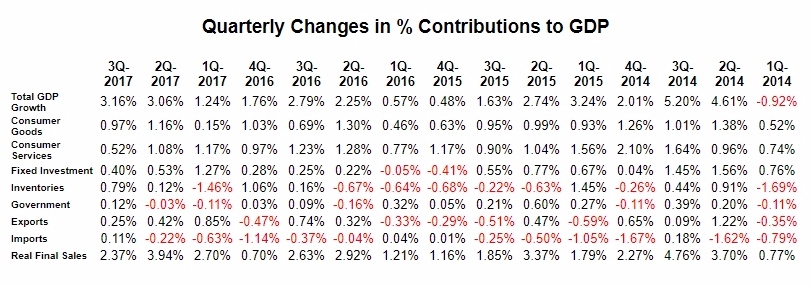BEA Revises 3rd Quarter 2017 GDP Growth Down Slightly To 3.16%
In their third and final estimate of the US GDP for the third quarter of 2017, the Bureau of Economic Analysis(BEA) reported that the US economy was growing at a +3.16% annual rate, down -0.14% from the previous estimate and up +0.10% from the prior quarter.
All of the revisions to the data could arguably be characterized as merely statistical noise. Certainly, none of them are material. The changes from the prior estimate reflect higher consumer goods spending, less spending on consumer services, offsetting minor adjustments to commercial fixed investment and inventory growth, slightly more governmental spending and slightly weaker foreign trade. The BEA's "bottom line" (their "Real Final Sales of Domestic Product", which excludes inventories) decreased to +2.37%, down -0.57% from the prior quarter.
Real annualized household disposable income rose +$8 to $39,225 (in 2009 dollars). The household savings rate remained unchanged at 3.3%, staying at the lowest level recorded since the fourth quarter of 2007.
For this revision, the BEA assumed an effective annualized deflator of 2.08%. During the same quarter (July 2017 through September 2017) the inflation recorded by the Bureau of Labor Statistics (BLS) in their CPI-U index was 4.31%. Underestimating inflation results in optimistic growth rates, and if the BEA's "nominal" data was deflated using CPI-U inflation information the headline growth number would have been materially lower at a +1.00% annualized growth rate.
Among the notable items in the report :
-- The headline contribution from consumer expenditures for goods was reported to be slightly stronger at +0.97% (although that is down -0.19% from the prior quarter).
-- The contribution to the headline from consumer spending on services dropped -0.19% to +0.52% (down -0.56% from the prior quarter). The combined consumer contribution to the headline number was +1.49%, down -0.75% from 2Q-2017.
-- The headline contribution from commercial private fixed investments increased slightly to +0.40%, up +0.01 from the previous estimate but still down -0.13% from the prior quarter. That continued to reflect a contraction in residential construction.
-- Inventory growth continued to provide a material boost to the headline number (+0.79%). This was a +0.67% improvement from the prior quarter. It is important to remember that the BEA's inventory numbers are exceptionally noisy (and susceptible to significant distortions/anomalies caused by commodity price or currency swings) while ultimately representing a zero reverting (and long-term essentially zero-sum) series.
-- Governmental spending was reported to be growing at a +0.12% rate. This was a +0.15% improvement from the prior quarter.
-- Exports contributed +0.25% to the headline number, down -0.17% from the prior quarter.
-- Imports added +0.11% to the headline, which was up +0.33% from the prior quarter. In aggregate, foreign trade added +0.36% to the headline number.
-- The "real final sales of domestic product" grew at an annualized 2.37%, down -0.57% from the prior quarter. This is the BEA's "bottom line" measurement of the economy and it excludes the inventory data.
-- As mentioned above, real per-capita annual disposable income reportedly rose +$8 per annum. At the same time the household savings rate was reported to have stayed at 3.3% (down -0.4% from the prior quarter). It is important to keep this line item in perspective: real per-capita annual disposable income is up only +6.95% in aggregate since the second quarter of 2008 -- a meager annualized +0.73% growth rate over the past 37 quarters.
The Numbers, as Revised
As a quick reminder, the classic definition of the GDP can be summarized with the following equation :
GDP = private consumption + gross private investment + government spending + (exports - imports)
or, as it is commonly expressed in algebraic shorthand :
GDP = C + I + G + (X-M)
In the new report the values for that equation (total dollars, percentage of the total GDP, and contribution to the final percentage growth number) are as follows :

The quarter-to-quarter changes in the contributions that various components make to the overall GDP can be best understood from the table below, which breaks out the component contributions in more detail and over time. In the table below we have split the "C" component into goods and services, split the "I" component into fixed investment and inventories, separated exports from imports, added a line for the BEA's "Real Final Sales of Domestic Product" and listed the quarters in columns with the most current to the left :

Summary and Commentary
The BEA generally gets its numbers right at times when the economy and economic growth are relatively stable. We suspect that these particular numbers are not likely to be significantly revised during the next annual historical revisions in July 2018. The notable takeaways from this report are :
-- Inventory growth provides a quarter of the headline number. As mentioned before, inventory growth is noisy and mean reverting. What it gives in this quarter it will take away somewhere down the road.
-- Despite rising and inescapable healthcare costs, the growth in spending on consumer services was the lowest since the second quarter of 2013. The consumer services sector has been a major driving factor in this economy over the past decade, and that growth may very well have maxed out.
-- Household disposable income remains miserable. There remains no material growth and savings remains at the lowest levels since the very bottom of the "Great Recession." This means that a significant portion of the already softening consumer spending came from savings, not paychecks.
A relatively stable headline number that is somewhat above 3% is just cause for satisfaction, if not celebration. Inventory buildups and stressed households are the cautionary tales in this final 3Q-2017 report.
Disclosure: None



